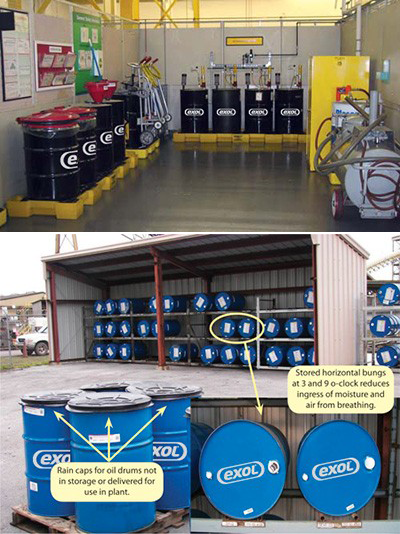Lubricants Storage Advice
The quality of Exol lubricants leaving the blending plant is closely monitored and controlled.
Stringent care is taken in manufacture, in packaging and in transportation to ensure that the products are free from contaminants, and fully meet or exceed their stated specifications. However, once the lubricants leave the care of Exol or its agents, their continuing fitness for use may depend on the quality of subsequent storage or handling procedures.
These notes set out some guidelines for maintaining Exol lubricants in the good, clean conditions essential for effective service.
Siting the lubricants store
Ideally lubricants should be stored under cover of a reasonably constant, moderate temperature. In practice, this may not be possible and the lubricants store may have to be at least partly outdoors. Whether it is outdoors or under cover, the store should be sited so as to provide:
- Good access for delivery vehicles
- Plenty of vehicle unloading room
- Properly equipped unloading dock with direct access to the oil store
- Clean, dust free conditions for unsealing and dispensing
- Easy distribution to the principal points of use
- Simple inventory control and at-a-glance check on the conditions of containers
- Space for empty barrels and returnable containers

Outdoor storage
If protected from extremes of temperature and from ingress of water, most lubricants are unaffected by climatic conditions and may be stored outdoors for limited periods. However, if temperatures below 0°C are anticipated, protection should be given to lubricants which are sensitive to the effects of frost (e.g. oil/water emulsions or water extendible fluids).
The following products should never be stored in the open:
- Insulating Oils
- Refrigerator Oils
- White and Medicinal Oils
- Greases
Neat Cutting Oils contain fatty oils or other compounds which can solidify and separate when very cold. It is also preferable for packaged lubricants to be opened under cover and be subsequently stored under cover.
The risk of contamination is greatly increased when lubricants are decanted or dispensed outdoors. Condensation or water ingress is more likely when a barrel is only part-full. Oil barrels standing in the open suffer variations in temperature, and corresponding variations in internal pressure. This leads to "breathing" where there is a leaking seal, with moisture liable to be drawn in - particularly if the barrel is standing bung-up, for the top of the barrel forms a rain trap.
Water on top of the barrel can also cause rusting, and the obliteration of markings. For these reasons barrels should be stored tilted, on their side, or bungs-down. The bungs of tilted or horizontal barrels should be of the 3 o'clock and 9 o'clock positions, to help ensure the gaskets are kept in contact with the oil in the barrel. In every case, barrels should be stored off the ground on stillages or in racks, well clear of surface water. They must never stand directly on a surface containing corrosive clinker. Regular examination should be made for signs of corrosion, for obscuring of identification marks, and for evidence of weakening seams or seals.
Special care should also be taken with the storage of smaller packages such as drums or pails. These are not designed to withstand severe weather. If outdoor storage is unavoidable, they should be placed under cover on stillages, or protected from rain by tarpaulins while ensuring the free circulation of air.
For further information please contact us:
Email: info@exol-lubricants.com | Tel: +44 (0) 121 568 6800

